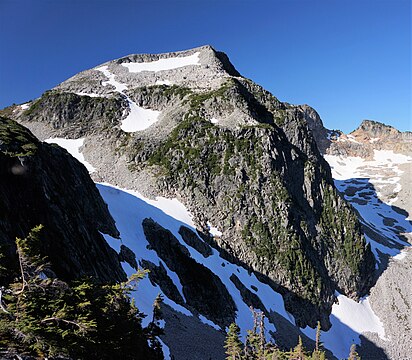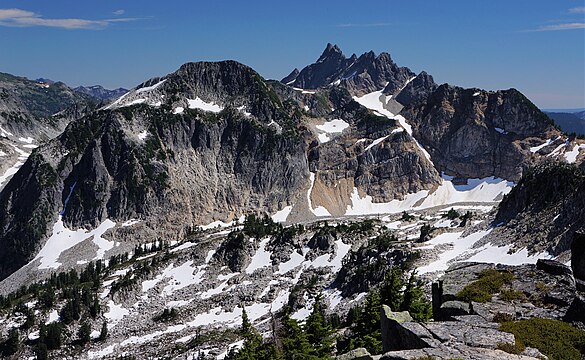
Overcoat Peak is in Mount Baker-Snoqualmie National Forest in the U.S. state of Washington. Overcoat Peak is less than .40 mi (0.64 km) northwest of Chimney Rock and both are within the Alpine Lakes Wilderness. Overcoat Glacier is on the east slopes of Overcoat Peak.

Chikamin Peak is a 6,994-foot (2,132-metre) mountain summit located in the Cascade Range, in Kittitas County of Washington state. It is situated within the Alpine Lakes Wilderness on land managed by the Okanogan–Wenatchee National Forest. The mountain's name "Chikamin" derives from Chinook Jargon meaning "money" or "metal", and was submitted by Edmond S. Meany, president of The Mountaineers. This name was officially adopted in 1916 by the U.S. Board on Geographic Names. Chikamin Peak is the highest point of Chikamin Ridge, six miles (9.7 km) northeast of Snoqualmie Pass. Other notable peaks on Chikamin Ridge include Four Brothers and Three Queens. Precipitation runoff from this mountain drains into tributaries of the Yakima River. The Pacific Crest Trail traverses the southwest slope of Chikamin Ridge, and from the trail a scramble up a gully leads to the summit and several alpine lakes including Chikamin Lake and Spectacle Lake.

Red Mountain is a 5,890-foot (1,795-metre) mountain summit located in King County of Washington state. It is set within the Alpine Lakes Wilderness which is part of the Cascade Range. Red Mountain is situated three miles north of Snoqualmie Pass on land managed by Mount Baker-Snoqualmie National Forest. The nearest higher neighbor is Lundin Peak, 0.7 mi (1.1 km) to the northwest. Precipitation runoff on the north side of the mountain drains into Middle Fork of the Snoqualmie River, whereas the south side of the mountain drains into the South Fork Snoqualmie River via Commonwealth Creek.

Kendall Peak is a mountain located on the county line separating King County and Kittitas County of Washington state. It is within the Alpine Lakes Wilderness on the crest of the Cascade Range. Kendall Peak is situated two miles northeast of Snoqualmie Pass on land managed by Mount Baker-Snoqualmie National Forest. Precipitation runoff on the east side of the mountain drains into Silver Creek and makes its way to the Columbia River via Yakima River, whereas the west side of the mountain drains into the South Fork Snoqualmie River via Commonwealth Creek. The Pacific Crest Trail traverses its west flank and an exposed section of the trail called Kendall Katwalk has seen tragic deaths over the years, most recently September 5, 2018. The nearest higher peak is Red Mountain, 0.9 miles (1.4 km) to the north-northwest.

Chair Peak is a 6,238 ft (1,900 m) mountain summit located in east King County of Washington state. It's part of the Cascade Range and is set within the Alpine Lakes Wilderness. Chair Peak is situated three miles northwest of Snoqualmie Pass on land managed by Mount Baker-Snoqualmie National Forest. Precipitation runoff from this mountain drains into tributaries of the Snoqualmie River. Chair Peak is located immediately south of Snow Lake which is a popular hiking destination. Topographic relief is significant as the summit rises approximately 2,200 feet (670 m) above Snow Lake in 0.5 mi (0.80 km). The nearest higher neighbor is Kaleetan Peak, 0.57 miles (0.92 km) to the west-northwest.
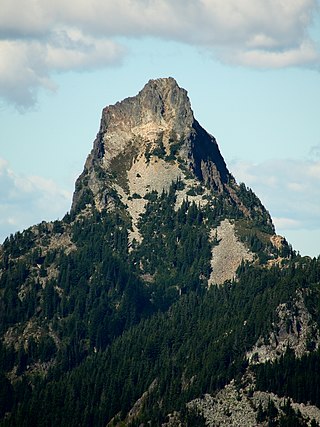
Kaleetan Peak is a prominent 6,259-foot (1,908-metre) mountain summit located in King County of Washington state. It's part of the Cascade Range and is situated four miles northwest of Snoqualmie Pass. Kaleetan Peak is set within the Alpine Lakes Wilderness on land managed by Mount Baker-Snoqualmie National Forest. It's immediately west of Melakwa Pass and Chair Peak, and north of Melakwa Lake. Precipitation runoff from the mountain drains into tributaries of the Snoqualmie River. Topographic relief is significant as the summit rises approximately 2,400 feet (730 m) above Kaleetan Lake in 0.6 mi (0.97 km). The nearest higher peak is Snoqualmie Mountain, 2.89 miles (4.65 km) to the east. The mountain's name "Kaleetan" derives from Chinook Jargon which means "arrow". The peak was named by members of The Mountaineers and the toponym was officially adopted in 1916 by the U.S. Board on Geographic Names.
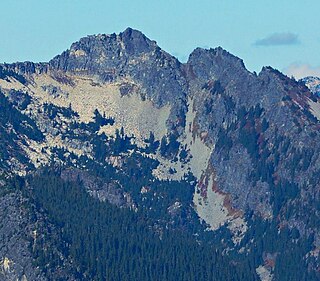
Lundin Peak is a summit located in King County of Washington state. It is part of the Cascade Range and is within the Alpine Lakes Wilderness. Lundin Peak is situated three miles north of Snoqualmie Pass on land managed by Mount Baker-Snoqualmie National Forest. Lundin Peak is a high point on a ridge located midway between Snoqualmie Mountain and Red Mountain. Precipitation runoff from the mountain drains into tributaries of the Snoqualmie River. Originally called Snoqualmie Little Sister, the peak's toponym was changed in 1931 to honor district forest ranger John Lundin.

Huckleberry Mountain is a 6,320+ ft summit located on the shared border of King County and Kittitas County in Washington state.
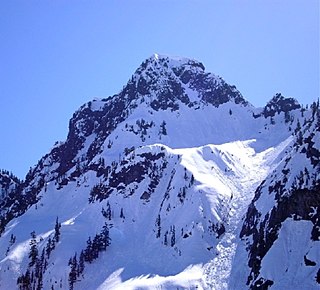
Bryant Peak is a 5,801-foot (1,768-metre) summit located in King County of Washington state. It's part of the Cascade Range and is within the Alpine Lakes Wilderness. Bryant Peak is located northwest of Snoqualmie Pass and the Alpental ski area, on land managed by Mount Baker-Snoqualmie National Forest. Bryant Peak is located south of Snow Lake which is a popular hiking destination. The nearest higher neighbor is Chair Peak, 0.65 miles (1.05 km) to the northwest. Originally called Hemlock Peak, Bryant Peak was renamed in 1925 to honor Sidney V. Bryant of The Mountaineers who made the first ascent of Kaleetan Peak in 1914. Precipitation runoff from the mountain drains into tributaries of the Snoqualmie River.

The Tooth is the descriptive name for a 5,606-foot-elevation (1,709-meter) fin-like, andesite pillar located in King County of Washington state. It is part of the Cascade Range and is within the Alpine Lakes Wilderness. The Tooth is located northwest of Snoqualmie Pass and the Alpental ski area on land managed by Mount Baker-Snoqualmie National Forest. The nearest higher peak is Bryant Peak, 0.44 miles (0.71 km) to the northwest. Originally called Denny Horn and Denny Tooth, The Tooth became the officially recognized name in 1918, with Denny referring to its position on the high ridge between Denny Mountain and Chair Peak. The Tooth is a popular rock-climbing destination, even in winter. The easiest route is class 4 scrambling, but solid rock provides technical routes, with the South Face considered a classic 5.4 climb that was first done in 1928 by Anderson and Wunderling.

Preacher Mountain is a broad summit located in King County of Washington state. It's located at the western edge of the Cascade Range and is within the Alpine Lakes Wilderness on land managed by Mount Baker-Snoqualmie National Forest. The nearest higher peak is Kaleetan Peak, 3.11 miles (5.01 km) to the southeast. The Pulpit is situated 2.19 miles to the northwest. Precipitation runoff from the mountain drains into tributaries of the Snoqualmie River.

Summit Chief Mountain is a 7,467-foot (2,276-meter) mountain summit located on the county line separating King County and Kittitas County in Washington state. It is entirely within the Alpine Lakes Wilderness, on land managed by Mount Baker-Snoqualmie National Forest. Summit Chief Mountain is situated on the crest of the Cascade Range, nine miles northeast of Snoqualmie Pass. Precipitation runoff from the west side of the mountain drains into tributaries of the Snoqualmie River, whereas the east side drains into tributaries of the Yakima River. The nearest higher peak is Chimney Rock, 1.29 miles (2.08 km) to the southwest.

Hibox Mountain is a 6,550-foot (1,996-metre) mountain summit located in the Cascade Range in Kittitas County of Washington state. It is situated within the Alpine Lakes Wilderness on land managed by Okanogan-Wenatchee National Forest. The mountain's name "Hibox" is a portmanteau which is derived from its position as the high point of Box Ridge. The peak is five miles east of Snoqualmie Pass, and Alta Mountain lies 1.5 miles to the west-northwest of Hibox. Precipitation runoff from the mountain drains into Box Canyon Creek and Mineral Creek which both empty to Kachess Lake. Topographic relief is significant as the summit rises 3,250 feet above Box Canyon in one mile (1.6 km).
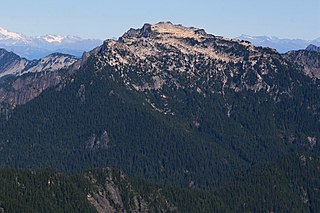
Big Snow Mountain is a prominent 6,680-foot (2,040-metre) mountain summit located 7 mi (11 km) north of Snoqualmie Pass in the Alpine Lakes Wilderness in eastern King County of Washington state. It is part of the Cascade Range and is situated on land managed by Mount Baker-Snoqualmie National Forest. Precipitation runoff from the mountain drains into tributaries of the Snoqualmie and Skykomish Rivers. The nearest higher peak is Overcoat Peak, 3.75 mi (6.04 km) to the east-southeast.
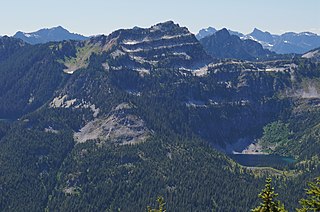
Terrace Mountain is a 6,361-foot (1,939-metre) mountain summit located in the Alpine Lakes Wilderness in eastern King County of Washington state. It is part of the Cascade Range and is situated on land managed by Mount Baker-Snoqualmie National Forest. The peak is situated 4 mi (6.4 km) north of Mount Daniel, and is surrounded by Lake Clarice, Marmot Lake, Ptarmigan Lakes, and the Terrace Lakes. Precipitation runoff from the mountain drains into tributaries of the Skykomish River. Topographic relief is significant as the summit rises over 1,800 feet above Lake Clarice in less than one-half mile (0.8 km). The mountain's descriptive name stems from the terrace-like appearance created by a series of benches on its east aspect.

Alaska Mountain is a 5,745-foot (1,751-metre) mountain summit located in the Cascade Range, in Kittitas County of Washington state. It is situated within the Alpine Lakes Wilderness on land managed by Wenatchee National Forest. Alaska Mountain is set between Alaska Lake and Joe Lake, 8 miles (13 km) northeast of Snoqualmie Pass, and 0.81 miles (1.30 km) southeast of Mount Thomson, which is also its nearest higher peak. The Pacific Crest Trail traverses around the south, east and north slopes of Alaska Mountain, and an off-trail hike leads to the summit. Precipitation runoff on the east side of the mountain drains into tributaries of the Yakima River, whereas the west side of the peak drains into tributaries of the Snoqualmie River.
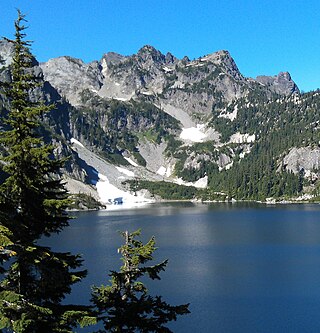
Mount Roosevelt is a 5,835-foot (1,779-metre) mountain summit located six miles (9.7 km) northwest of Snoqualmie Pass, in east King County of Washington state. It's part of the Cascade Range and is situated within the Alpine Lakes Wilderness, on land managed by Mount Baker-Snoqualmie National Forest. Mount Roosevelt is set above the western shore of Snow Lake, and two miles (3.2 km) immediately north of Kaleetan Peak, which is the nearest higher neighbor. Precipitation runoff from the mountain drains into tributaries of the Snoqualmie River. This mountain's toponym was officially adopted in 1989 by the U.S. Board on Geographic Names.

Little Big Chief Mountain is a 7,225-foot (2,202-metre) mountain summit located immediately southwest of Dutch Miller Gap, on the common border separating King County and Kittitas County in Washington state. It is situated within the Alpine Lakes Wilderness, on land managed by Mount Baker-Snoqualmie National Forest. Little Big Chief Mountain is set ten miles northeast of Snoqualmie Pass on the crest of the Cascade Range. Precipitation runoff from the west side of the mountain drains into tributaries of the Snoqualmie River, whereas the east side drains into tributaries of the Yakima River. The nearest higher peak is Summit Chief Mountain, 0.7 miles (1.1 km) to the southwest, and Chimney Rock is set 2.2 miles (3.5 km) to the southwest. The first ascent of this peak was made in August 1939 by Fred Beckey, Wayne Swift, Joe Barto, and Campbell Brooks. This mountain was named for Lorenz A. Nelson during the 1925 Mountaineers climb of Summit Chief Mountain. Nelson was a pioneering mountaineer who led first ascents of Mount Olympus, Mount Meany, and Chiwawa Mountain.

Iron Cap Mountain is a 6,347-foot (1,935-metre) mountain summit located two miles west-northwest of Dutch Miller Gap, in east King County of Washington state. It is situated in the heart of the Alpine Lakes Wilderness, on land managed by Mount Baker-Snoqualmie National Forest. Iron Cap Mountain is set two miles west of the crest of the Cascade Range. Precipitation runoff from the south side of the mountain drains into tributaries of the Snoqualmie River, whereas the north side drains into tributaries of the Foss River. Although modest in elevation, relief is significant since Iron Cap rises 2,500 feet above the Middle Fork Snoqualmie River Valley in less than one mile. Its neighbors include La Bohn Peak, 1.77 miles (2.85 km) to the east, and Little Big Chief Mountain, 2.14 miles (3.44 km) to the southeast.

Wright Mountain is a 5,430-foot-elevation mountain summit located 11 mi (18 km) northwest of Snoqualmie Pass, in east King County of Washington state. It is part of the Cascade Range and is situated within the Alpine Lakes Wilderness, on land managed by Mount Baker-Snoqualmie National Forest. Wright Mountain is set above the northern shore of Gem Lake, and less than one mile north-northwest of Snow Lake. Neighbors within two miles include Kaleetan Peak, Chair Peak, and Mount Roosevelt, which is its nearest higher neighbor. Precipitation runoff from the mountain drains into tributaries of the Snoqualmie River. This mountain's name was officially proposed as Mount Wright in 1925 by The Mountaineers, and amended to Wright Mountain in 1968 by the U.S. Board on Geographic Names, to commemorate George E. Wright, a prominent Seattle attorney and mountaineer who was active in establishing Olympic National Park. Wright died October 9, 1923.



